Steel Mill Gantry Cranes for Large Steel Beam Handling 5 T, 10T
Steel Mill Gantry Cranes for Large Steel Beam Handling
In the steel manufacturing, few tools are as indispensable as gantry cranes. These towering structures, with their robust frames and powerful lifting mechanisms, play a crucial role in the movement of heavy materials within steel mills. Today, we delve into the specialized realm of gantry cranes designed specifically for handling large steel beams.
Gantry cranes are the backbone of steel mills, providing the muscle needed to transport raw materials, intermediate products, and finished goods throughout the facility. Their versatility and efficiency make them essential for maintaining the smooth operation of steel manufacturing processes.
Types of Steel Mill Gantry Cranes for Large Steel Beam Handling:
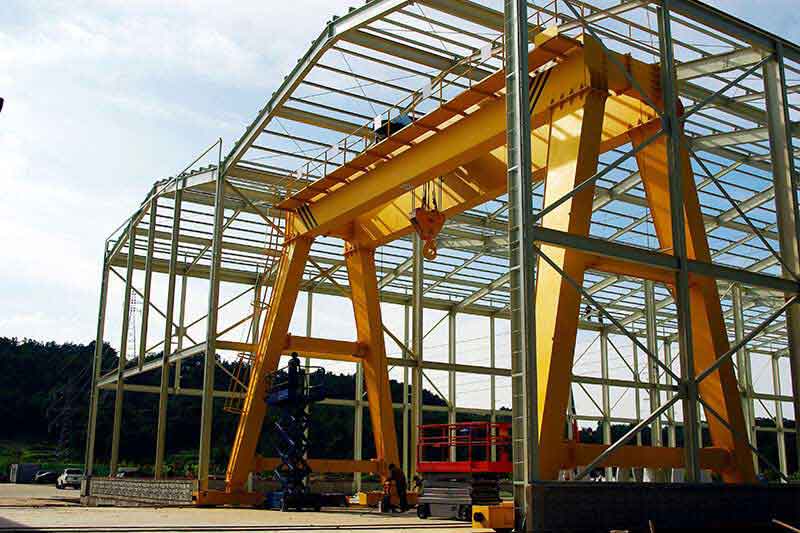
Double Girder Steel Mill Gantry Crane:
- Features: This crane design boasts two parallel bridge girders supported by end trucks, providing robust support and stability in steel mill environments.
- Benefits: Double girder steel mill gantry cranes offer higher lifting capacities and enhanced stability, making them ideal for handling large and heavy steel beams with precision.
- Typical Applications: These cranes excel in heavy-duty applications within steel mills, where they are utilized for tasks such as loading and unloading large steel beams from trucks, transporting materials within the facility, and precise positioning during production processes.
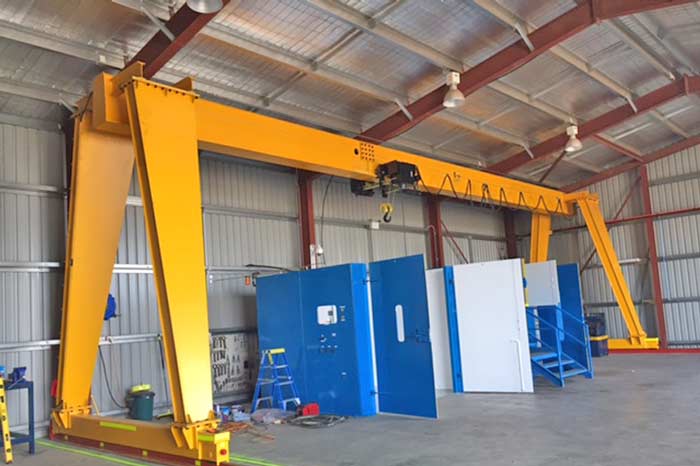
Single Girder Steel Mill Gantry Crane:
- Features: Single girder steel mill gantry cranes feature a single bridge girder supported by end trucks, offering a more compact and cost-effective design for steel mill operations.
- Benefits: While they have lower lifting capacities compared to double girder designs, single girder steel mill gantry cranes are versatile and suitable for handling lighter loads of steel beams. They offer flexibility in smaller spaces within steel mills.
- Typical Applications: These cranes are commonly used for tasks such as material handling in smaller workshops, loading and unloading of materials from storage areas, and general-purpose lifting within steel mills.
Box Girder Steel Mill Gantry Crane:
- Features: Box girder steel mill gantry cranes feature a box-shaped girder structure, providing increased strength and stiffness for demanding steel mill environments.
- Benefits: With improved load-bearing capacity and resistance to torsional forces, these cranes are ideal for handling heavy steel beams with precision and stability in steel mill operations.
- Typical Applications: Box girder steel mill gantry cranes are utilized in heavy fabrication areas, steel beam production lines, and shipbuilding yards within steel mills, where high loads and demanding operating conditions are prevalent.
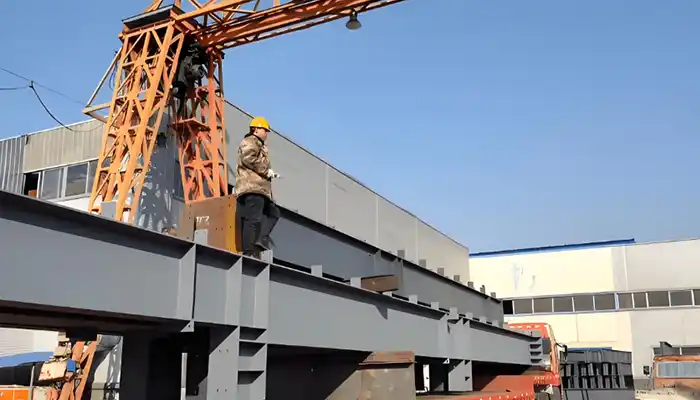
Truss Girder Steel Mill Gantry Crane:
- Features: Truss girder steel mill gantry cranes feature an open-web truss structure, offering a high strength-to-weight ratio and resistance to bending and torsional forces in steel mill environments.
- Benefits: These cranes provide excellent stability and reliability for handling large steel beams in various weather conditions, making them suitable for outdoor applications in steel mills.
- Typical Applications: Truss girder steel mill gantry cranes are commonly used in outdoor yards within steel mills for tasks such as loading and unloading materials from ships, handling oversized steel beams, and transporting materials across large spans.
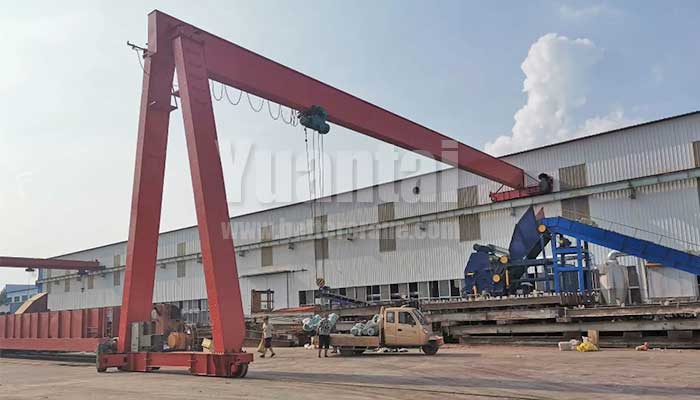
- Features: Semi-gantry steel mill cranes feature one end supported by a runway beam, while the other end travels on wheels along a ground-level track or rail, providing flexible lifting solutions in steel mill environments.
- Benefits: Combining the flexibility of gantry cranes with the efficiency of overhead cranes, semi-gantry steel mill cranes are suitable for handling large steel beams in areas with space constraints or existing infrastructure limitations.
- Typical Applications: These cranes are utilized in steel mills for tasks such as loading and unloading materials from trucks and railcars, transferring materials between indoor and outdoor storage areas, and providing overhead lifting solutions in confined spaces.
Specialized Features for Large Steel Beam Handling:
- Extended Spans:Gantry cranes designed for handling large steel beams may feature extended spans to accommodate the length of the beams, ensuring ample clearance during lifting and transferring operations.
- Heavy-Duty Construction:To withstand the weight and size of large steel beams, gantry cranes are constructed with heavy-duty materials, reinforced frames, and robust components to ensure structural integrity and stability during lifting and movement.
- Variable Speed Controls:Variable speed controls allow operators to adjust the speed of crane movements, providing precise control during the handling of large steel beams and ensuring smooth and efficient operations.
- Advanced Safety Systems:Specialized safety systems, such as overload protection, anti-sway control, and collision avoidance technology, are integrated into gantry cranes to enhance safety during large steel beam handling operations, protecting both personnel and equipment.
Specialized Steel Beam Handling Below Hook Devices for Steel Mill Gantry Cranes:
- Spreader Beams:Spreader beams are below-hook lifting devices designed to evenly distribute the weight of large steel beams, ensuring balanced lifting and preventing damage or deformation.
- Magnetic Lifters:Magnetic lifters utilize powerful magnets to lift and transport large steel beams, offering a safe and efficient method for handling ferrous materials in steel mills.
- Vacuum Lifters:Vacuum lifters use suction cups to grip and lift large steel beams, providing a non-marking and damage-free lifting solution for delicate materials.

Optimization of Gantry Cranes for Large Steel Beam Handling
Gantry cranes designed for handling large steel beams undergo a meticulous optimization process to ensure they meet the demanding requirements of steel mills. Let's delve into the unique features, specifications, and optimization strategies employed in these specialized cranes.
Unique Features and Specifications
Gantry cranes engineered for handling large steel beams boast several unique features and specifications tailored to the task at hand. These include:
- Robust Structural Design: The gantry crane's structure is reinforced to withstand the heavy loads associated with steel beam handling. High-strength materials and welding techniques are utilized to ensure durability and longevity.
- Large Capacity Range: Gantry cranes for large steel beam handling typically have a capacity range spanning from 30 tons to 150 tons, allowing them to lift and maneuver beams of varying sizes and weights with ease.
- Spacious Clearances: Ample clearance between the crane's lifting mechanism and the ground allows for the efficient handling of oversized steel beams without obstruction.
Optimization for Efficient and Safe Handling
Gantry cranes undergo rigorous optimization to ensure efficient and safe handling of heavy loads, including large steel beams. Key optimization strategies include:
- Capacity Range Optimization: Gantry cranes are designed with a broad capacity range to accommodate different sizes and weights of steel beams encountered in steel mills. This flexibility allows for versatile and efficient material handling operations.
- Structural Design Considerations: The structural design of gantry cranes is carefully engineered to prioritize stability and strength. Factors such as beam size, girder configuration, and bracing arrangements are optimized to withstand the dynamic loads exerted during beam handling.
- Lifting Mechanisms and Attachments: Specialized lifting mechanisms and attachments are tailored for handling steel beams safely and efficiently. These may include spreader bars, C-hooks, or electromagnets designed to securely grip and transport beams without slippage or damage.
By optimizing gantry cranes for efficient and safe handling of large steel beams, steel mills can streamline their material handling processes, improve productivity, and enhance workplace safety. These optimized cranes serve as indispensable assets in the dynamic and demanding environment of steel manufacturing.
Specific Examples of Gantry Crane Applications in Steel Manufacturing Facilities
Overview of Beam Production and Fabrication Processes in Steel Mills
Before delving into specific examples of gantry crane applications, it's essential to understand the beam production and fabrication processes in steel mills. These processes typically involve several stages, each requiring precise material handling:
- Raw Material Preparation: Beam production begins with the preparation of raw materials, which typically include steel ingots or billets. These raw materials are transported to the mill's staging area for further processing.
- Melting and Casting: The raw materials are melted in a furnace and then poured into casting molds to form steel billets or blooms. These semi-finished products serve as the starting material for beam production.
- Rolling and Shaping: The steel billets or blooms are heated and passed through a series of rolling mills to gradually shape them into the desired beam profile. This process may involve multiple passes through different rolling stands to achieve the required dimensions.
- Cooling and Inspection: After rolling, the newly formed beams are cooled using water or air to stabilize their structure. They are then subjected to rigorous quality inspection processes to ensure they meet industry standards for strength, dimensions, and surface finish.
- Cutting and Finishing: Once inspected, the beams may undergo additional cutting or finishing processes to trim excess material and achieve precise lengths or profiles. This may involve sawing, drilling, or machining operations.
- Storage and Distribution: Finished beams are then stored in the mill's warehouse or yard before being shipped to customers or used in downstream manufacturing processes. Efficient material handling and storage are critical to optimizing workflow and minimizing lead times.
Throughout these production and fabrication processes, gantry cranes play a pivotal role in handling steel beams at various stages. They are used for transporting raw materials, moving semi-finished products between production stations, and loading finished beams onto trucks or railcars for distribution.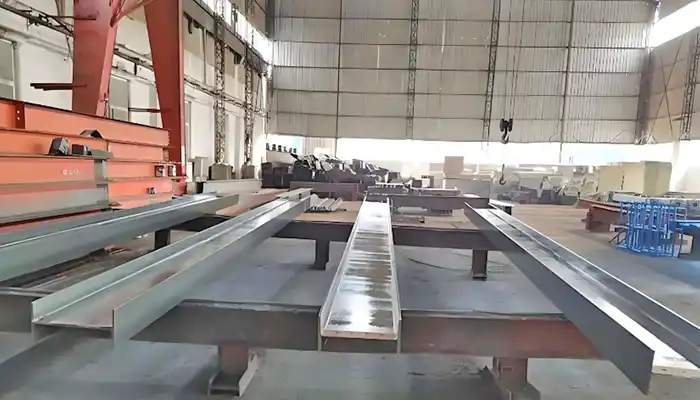
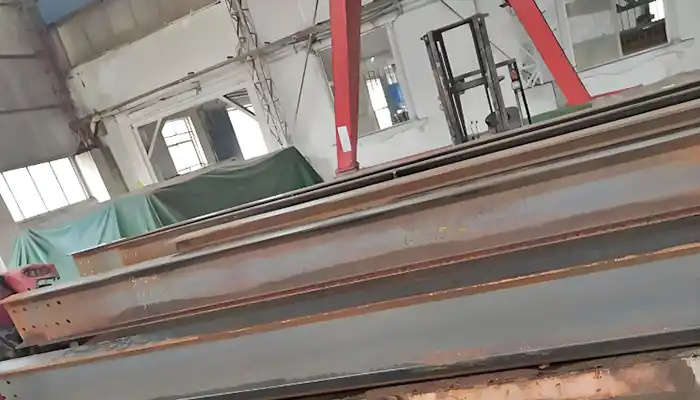
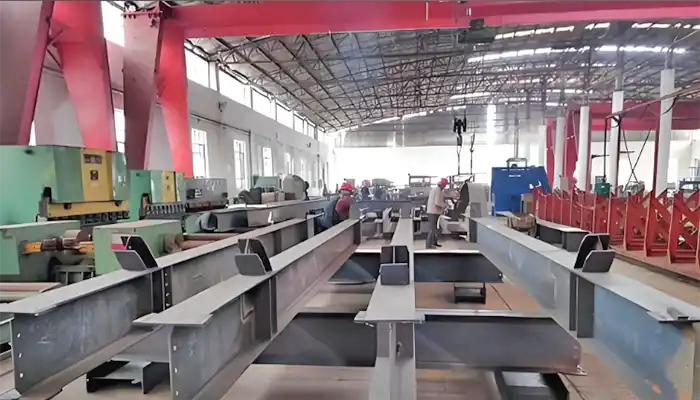
Specific Examples of How Gantry Cranes Support These Processes in Different Countries:
China
China stands as a global powerhouse in steel production, with a vast network of state-of-the-art manufacturing facilities sprawled across the nation. These facilities range from massive integrated steel mills to specialized plants focusing on specific steel products. China's steel industry is characterized by its scale, efficiency, and technological advancements, making it a dominant player in the global steel market.
Role of Gantry Cranes in Transporting and Positioning Steel Beams:
Gantry cranes play a pivotal role in China's steel manufacturing facilities, facilitating the seamless movement of steel beams throughout the production process. In large-scale integrated mills, gantry cranes are deployed in primary metal production areas, such as blast furnaces and continuous casting lines, where they are responsible for transporting raw materials, handling semi-finished products, and feeding materials into downstream processing units.
In the beam production and fabrication processes, gantry cranes are utilized to transport hot-rolled steel sections from rolling mills to cooling beds, where they are allowed to cool and stabilize before further processing. Subsequently, gantry cranes assist in the movement of cooled beams to inspection stations, cutting lines, and storage areas within the facility. Their versatility and lifting capacity allow for efficient handling of beams of various sizes and weights, ensuring smooth workflow and minimizing downtime.
Impact of Gantry Crane Efficiency on China's Steel Industry:
The efficiency and reliability of gantry cranes have a significant impact on China's steel industry, driving productivity, cost-effectiveness, and competitiveness in the global market. With the rapid expansion of China's steel production capacity and the increasing demand for high-quality steel products, gantry cranes play a crucial role in meeting production targets, optimizing material handling processes, and reducing operational costs.
Efficient gantry crane operations translate into improved throughput, reduced cycle times, and enhanced safety in steel manufacturing facilities, thereby contributing to the overall efficiency and profitability of the industry. Moreover, by investing in advanced gantry crane technologies and automation systems, Chinese steel producers can further enhance their manufacturing capabilities, increase product quality, and maintain their leading position in the global steel market.
United States
The United States boasts a diverse array of steel manufacturing facilities, ranging from integrated mills to mini-mills, spread across different regions of the country. These facilities produce a wide range of steel products, including beams, plates, sheets, and structural components, serving various industries such as construction, automotive, and infrastructure.
Integrated steel mills, concentrated primarily in the Midwest, are equipped with blast furnaces, steelmaking converters, and rolling mills, allowing for the production of a broad spectrum of steel grades and products. Mini-mills, on the other hand, utilize electric arc furnaces to melt scrap steel and produce specialty steel products with greater flexibility and efficiency. Steel manufacturing facilities in the United States adhere to stringent quality standards and environmental regulations to ensure the production of high-quality steel while minimizing environmental impact.
Role of Gantry Cranes in Beam Production and Fabrication:
In steel manufacturing facilities across the United States, gantry cranes play a crucial role in beam production and fabrication processes. These robust cranes are deployed at various stages of the manufacturing process to handle steel beams with precision and efficiency.
At the rolling mills, gantry cranes are utilized to transport hot-rolled steel sections from the rolling line to cooling beds, where they are allowed to cool and solidify. Subsequently, gantry cranes assist in the movement of cooled beams to cutting and finishing stations, where they undergo further processing, such as cutting, drilling, and painting.
In large-scale fabrication shops, gantry cranes are essential for lifting and positioning steel beams during assembly and welding operations. Their high lifting capacity and versatility allow for the efficient handling of heavy steel components, ensuring smooth workflow and minimizing downtime.
Importance of Gantry Crane Reliability in Meeting Production Demands:
Reliable gantry crane operation is paramount to meeting production demands in steel manufacturing facilities in the United States. Any downtime or malfunction of gantry cranes can disrupt production schedules, leading to delays, increased costs, and decreased productivity.
Given the high-volume nature of steel production in the United States, gantry cranes are expected to operate continuously under demanding conditions. Therefore, gantry crane reliability is of utmost importance to ensure uninterrupted material handling and production flow.
By investing in reliable gantry crane systems equipped with advanced safety features and predictive maintenance technologies, steel manufacturers in the United States can minimize the risk of downtime, optimize production efficiency, and maintain their competitive edge in the global market.
Germany
Germany is renowned for its advanced steel manufacturing industry, characterized by cutting-edge technology, precision engineering, and high-quality products. Steel manufacturing facilities in Germany encompass a diverse range of operations, including integrated steel mills, specialty steel producers, and fabrication shops.
Integrated steel mills in Germany are equipped with state-of-the-art blast furnaces, converters, and rolling mills, allowing for the production of a wide range of steel grades and products. These facilities prioritize efficiency, quality control, and sustainability, adhering to strict environmental regulations and industry standards.
Specialty steel producers in Germany focus on manufacturing high-value-added steel products for niche markets, such as automotive, aerospace, and engineering applications. These facilities leverage advanced metallurgical processes and alloy formulations to produce specialty steels with exceptional properties and performance.
Fabrication shops in Germany specialize in the production of customized steel components and structures, catering to diverse industrial sectors. These shops utilize advanced machining, welding, and assembly techniques to fabricate complex steel products with precision and accuracy.
Innovation in Gantry Crane Technology for Beam Handling:
Germany is at the forefront of gantry crane technology innovation for beam handling applications. German manufacturers of gantry cranes continually strive to develop cutting-edge solutions that enhance efficiency, safety, and reliability in steel manufacturing operations.
Innovations in gantry crane technology for beam handling include:
- Advanced Control Systems: German gantry crane manufacturers incorporate sophisticated control systems that enable precise positioning, speed control, and load monitoring. These systems optimize crane performance and enhance operator safety.
- Automation and Robotics: Germany leads in the integration of automation and robotics technologies into gantry crane systems. Automated gantry cranes equipped with robotic arms and sensors can perform complex material handling tasks with minimal human intervention, increasing productivity and efficiency.
- Energy Efficiency: German gantry crane manufacturers prioritize energy efficiency in crane design and operation. By utilizing regenerative braking systems, variable frequency drives, and energy-efficient components, gantry cranes in Germany minimize energy consumption and environmental impact.
Integration of Gantry Cranes into Germany's Precision Engineering Processes:
Gantry cranes play a crucial role in Germany's precision engineering processes, ensuring the accurate handling and positioning of steel beams in manufacturing operations. In fabrication shops and assembly lines, gantry cranes are integrated seamlessly into production workflows, supporting the precise machining, welding, and assembly of steel components.
The integration of gantry cranes into Germany's precision engineering processes enables manufacturers to achieve tight tolerances, intricate geometries, and high-quality finishes in steel products. Whether lifting heavy steel beams or delicate components, gantry cranes in Germany are engineered to deliver exceptional performance, reliability, and precision.
Overall, gantry cranes are indispensable tools in Germany's steel manufacturing industry, driving innovation, efficiency, and excellence in engineering processes. Their integration into production facilities reflects Germany's commitment to technological advancement and quality craftsmanship in the global steel market.
Conclusion
Throughout this exploration, we've witnessed the indispensable role played by gantry cranes in the handling of large steel beams within steel manufacturing facilities. These towering structures, with their robust design and precision engineering, are the backbone of beam production and fabrication processes, ensuring the seamless movement of heavy materials with efficiency and reliability.
Summary of Key Points :
- Gantry cranes are optimized for handling large steel beams, with capacities ranging from 30 to 150 tons, and feature robust structural designs tailored to the demands of steel mills.
- Key considerations in the optimization of gantry cranes include capacity range, structural design for stability and strength, and specialized lifting mechanisms for steel beam handling.
- Specific examples highlighted the role of gantry cranes in steel manufacturing facilities in China, the United States, and Germany, emphasizing their importance in transporting, positioning, and processing steel beams.
- In China, gantry cranes support the nation's steel industry, driving productivity and efficiency in beam production processes.
- In the United States, gantry cranes are essential for meeting production demands and maintaining competitiveness in the global steel market.
- In Germany, gantry cranes embody innovation and precision engineering, integrating advanced technologies to optimize beam handling operations.
Gantry cranes stand as symbols of strength, efficiency, and innovation in the dynamic world of steel manufacturing. Their vital role in handling large steel beams ensures the smooth operation of steel mills, driving productivity, safety, and quality in manufacturing processes. As steel mills continue to evolve and embrace technological advancements, gantry cranes will remain indispensable tools, powering the growth and prosperity of the steel industry for generations to come.




